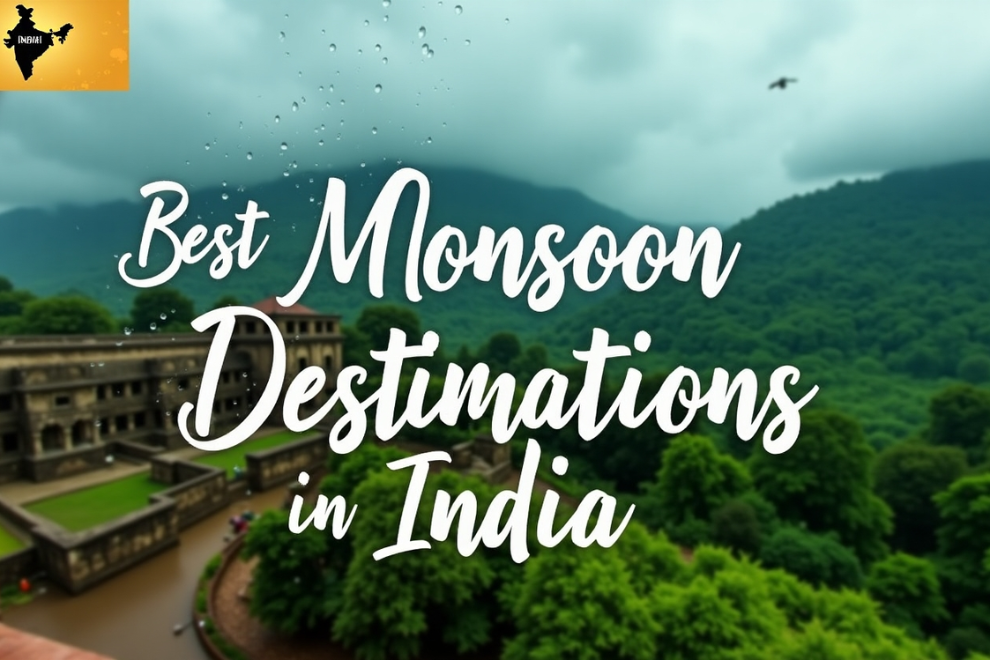Top 10 Best Monsoon Destinations in India to Visit During the Rainy Season

Monsoon in India transforms the country into a land of lush greenery, misty mountains, roaring waterfalls, and cool breezes. It’s a magical time when nature comes alive, making it the perfect season to explore some of India’s most scenic and peaceful destinations. If you’re planning a getaway during the rainy season, here are the best monsoon places in India that promise a refreshing and unforgettable experience. 1. Munnar, Kerala Why Visit: A hill station draped in emerald green tea gardens, Munnar becomes a monsoon paradise with its mist-covered hills and flowing streams.Highlights: Tea plantations, Attukal Waterfalls, Eravikulam National Park 2. Coorg, Karnataka Why Visit: Also known as the “Scotland of India”, Coorg turns even more beautiful during the rains with lush forests and gushing waterfalls.Highlights: Abbey Falls, coffee estates, Dubare Elephant Camp 3. Lonavala & Khandala, Maharashtra Why Visit: These twin hill stations near Mumbai and Pune come alive in monsoon with greenery, foggy weather, and scenic drives.Highlights: Bhushi Dam, Tiger’s Leap, Rajmachi Fort 4. Cherrapunji, Meghalaya Why Visit: One of the wettest places on earth, Cherrapunji is best experienced in monsoon with its dramatic waterfalls and dense clouds.Highlights: Nohkalikai Falls, Mawsmai Caves, living root bridges 5. Udaipur, Rajasthan Why Visit: Udaipur’s lakes and palaces look magical during the monsoon, offering a romantic and royal experience.Highlights: Lake Pichola, City Palace, Monsoon Palace 6. Kodaikanal, Tamil Nadu Why Visit: Known as the “Princess of Hill Stations”, Kodaikanal is serene during the rains with misty valleys and cool breezes.Highlights: Coaker’s Walk, Kodai Lake, Pillar Rocks 7. Valley of Flowers, Uttarakhand Why Visit: Monsoon is the only season when this UNESCO World Heritage Site blooms with vibrant flowers and stunning alpine beauty.Highlights: Rare Himalayan flora, scenic treks, snow-capped peaks 8. Goa Why Visit: While Goa is known for beaches and parties, monsoon offers a peaceful, green, and offbeat side of the region.Highlights: Dudhsagar Falls, spice plantations, monsoon treks 9. Shillong, Meghalaya Why Visit: With its rolling hills and heavy rain showers, Shillong offers a peaceful and picturesque retreat during the monsoon.Highlights: Elephant Falls, Ward’s Lake, scenic drives 10. Mahabaleshwar, Maharashtra Why Visit: A favorite monsoon retreat in the Western Ghats, Mahabaleshwar becomes a cloud-kissed landscape with rivers and valleys.Highlights: Arthur’s Seat, Venna Lake, Lingmala Waterfall Final Thoughts From the tea gardens of Munnar to the lush valleys of Meghalaya, monsoon adds a mystical charm to many places across India. These top monsoon destinations in India are perfect for travelers who love nature, peace, and the thrill of the rainy season. Pack your umbrella, embrace the mist, and set out on a journey to witness India’s greenest and most serene side.
Top 10 Must-Visit Places in the World for Every Travel Enthusiast

Traveling is not just about seeing new places — it’s about experiencing cultures, nature, architecture, and memories that last a lifetime. Whether you’re an adventure seeker, history lover, or nature admirer, the world is full of iconic destinations waiting to be explored. Here’s a curated list of the top 10 places to visit in the world that offer unforgettable experiences. 1. Paris, France Why Visit: Known as the “City of Love,” Paris is home to the iconic Eiffel Tower, Louvre Museum, Notre-Dame Cathedral, and charming street cafés.Highlights: Romantic ambience, world-class art, exquisite cuisine, and historical architecture. 2. Bali, Indonesia Why Visit: A tropical paradise known for its lush rice terraces, ancient temples, and serene beaches. Bali offers both relaxation and adventure.Highlights: Uluwatu Temple, Tegallalang Rice Terraces, and vibrant local markets. 3. Rome, Italy Why Visit: The Eternal City is a blend of ancient ruins, Renaissance art, and delicious Italian food. History comes alive in every corner of Rome.Highlights: Colosseum, Vatican City, Trevi Fountain, and Roman Forum. 4. Tokyo, Japan Why Visit: A futuristic city that seamlessly blends tradition and innovation. Tokyo is a hub of culture, fashion, technology, and culinary excellence.Highlights: Shibuya Crossing, Tokyo Tower, Senso-ji Temple, and sushi experiences. 5. Cape Town, South Africa Why Visit: With Table Mountain as its backdrop and oceans at its doorstep, Cape Town is one of the most naturally beautiful cities in the world.Highlights: Table Mountain, Robben Island, and Cape Winelands. 6. New York City, USA Why Visit: The “City That Never Sleeps” is packed with iconic landmarks, world-class museums, and vibrant neighborhoods.Highlights: Times Square, Statue of Liberty, Central Park, and Broadway. 7. Santorini, Greece Why Visit: Famous for its white-washed buildings, blue-domed churches, and dramatic sunsets. Santorini is a dream destination for romance and beauty.Highlights: Oia village, volcanic beaches, and caldera views. 8. Kyoto, Japan Why Visit: A peaceful city filled with shrines, Zen gardens, and traditional teahouses. It’s Japan’s cultural heart.Highlights: Fushimi Inari Shrine, Arashiyama Bamboo Grove, and geisha districts. 9. Dubai, UAE Why Visit: A city of opulence and architectural marvels, Dubai offers luxury, innovation, and desert adventures.Highlights: Burj Khalifa, Dubai Mall, Palm Jumeirah, and desert safaris. 10. Machu Picchu, Peru Why Visit: An ancient Incan city set high in the Andes, Machu Picchu is a UNESCO World Heritage site and a testament to human engineering.Highlights: Sacred Valley, Sun Gate hike, and mystical mountain views. Final Thoughts These top 10 places to visit in the world are more than just destinations — they are experiences that inspire, enlighten, and transform. Whether you crave history, culture, nature, or adventure, each of these places offers something extraordinary. Start building your bucket list and get ready to explore the wonders our world has to offer.
The Future of Wealth Building: Rethinking Passive Income for Smart Investors

In an economy shaped by fast-changing markets, AI disruption, and volatile real estate trends, “passive income” is no longer a buzzword; it’s a necessity. As inflation challenges traditional savings accounts and stock market swings leave investors dizzy, many are rethinking what smart, scalable income looks like. Gone are the days when passive income meant simply collecting rent on a single property or buying into a dividend-heavy index fund. The future of financial independence lies in strategic, diversified investing, especially when you want returns without constant management headaches. Moving Beyond One-Track Investing Entrepreneurs and professionals are often told to “invest in what you know.” While that’s not bad advice, it can limit your portfolio if you never venture into new terrain. Traditional passive income models like rental homes, small business stakes, or online course royalties require ongoing effort, risk tolerance, and sometimes a steep learning curve. Savvy investors are now looking for: This is where modern co-investment models are reshaping the landscape. The Rise of Passive Co-Investment Strategies One of the most innovative solutions emerging in the wealth-building space is the co-investment fund-of-funds model. This allows investors to pool capital into professionally managed, high-performing assets across multiple projects. This approach reduces exposure to any single investment while still capturing the upside of real estate, private equity, and other alternative assets. This co-investment strategy not only empowers investors to spread risk and diversify holdings but also offers access to opportunities that might otherwise be reserved for large institutional players. Think of it as collaborative investing with professionals at the wheel and less hands-on involvement for you. Why Passive Doesn’t Mean Powerless There’s a misconception that passive investors are disconnected or uninformed. In reality, the savviest investors are those who know how to evaluate partners, monitor performance metrics, and understand the levers behind their returns, even if they’re not managing the day-to-day operations. Key traits of a smart passive investor: The more informed your passive strategy, the more active your results will be. Scaling Smartly Without Burnout Many high performers hit a ceiling: they have the income, but not the time or energy to multiply it further. Passive income done right can provide freedom, financial and otherwise, without adding stress or endless decisions to your plate. A forward-looking passive income portfolio can include: What matters isn’t just what you invest in, but how you structure your financial ecosystem to work for you in the background. Passive Should Still Be Purposeful Building wealth in the modern world means evolving beyond one-size-fits-all investing. Whether you’re an executive with limited time or an entrepreneur planning your next phase, passive income isn’t about doing less; it’s about doing smarter. By choosing co-investment strategies that emphasize diversification, professional oversight, and scalability, you can create a financial life where your money does more of the work, and you gain the flexibility to pursue what matters most.
When Business Growth Breeds Conflict: Turning Tensions Into Strategic Leverage

Success stories often gloss over one key reality: the faster a company grows, the more complex its internal dynamics become. Whether it’s expanding partnerships, hiring rapidly, or navigating new markets, friction is inevitable. However, instead of seeing tension as a threat, forward-thinking leaders are learning to reframe it as a strategic checkpoint. Scaling a business can unearth dormant conflicts. What worked for five employees might unravel with 50. Once tight investor relationships can become strained by shifting expectations. The stakes are higher, and the tolerance for ambiguity is lower. Conflict as a Catalyst, Not a Crisis Business conflict doesn’t always stem from failure. It often arises from progress, when roles blur, expectations shift, or communication breaks down across growing teams. When companies treat these moments as natural byproducts of growth rather than red flags, they unlock more agile, resilient operational models. Common growth-related conflict zones include: Rather than panic at the first sign of tension, successful companies investigate the root of the issue and treat it as a learning opportunity. The Importance of Proactive Conflict Frameworks Having a conflict-resolution plan in place is a sign of maturity, not paranoia. Handling disputes with a clear, strategic lens helps companies avoid litigation, maintain trust, and protect their finances. Here’s what modern conflict-preparedness can look like: Planning for conflict allows leaders to focus on solving problems, not navigating emotional blowups. When to Involve Legal Support (and Why It’s Not Always a Bad Sign) Many business owners wait too long to seek legal counsel, fearing it will signal weakness or create unnecessary expense. Involving the proper legal support early on can do the opposite: it protects the business, streamlines the resolution process, and keeps relationships intact. Some examples of when to bring in a business litigation expert include: As the Burris Law team highlights, working with experienced dispute-resolution professionals isn’t about going to court; it’s about resolving conflict efficiently and with dignity. Don’t Just Solve, Strengthen After resolving a dispute, innovative companies don’t just move on. They review what went wrong, identify systemic weaknesses, and use the experience to build better systems. Ask: Use conflict not only to solve a specific problem but to improve your culture, policies, and future performance. Conflict in Partnerships It’s common to see early-stage co-founders dive into business together with passion but little formal planning. As the business grows, those initial verbal agreements and assumptions can turn into friction, especially around equity splits, decision-making rights, and company direction. To prevent conflict among co-founders: Conflicts between founders can be some of the most emotionally charged and damaging. Handling them with foresight is crucial to long-term stability. Don’t Let Tension Stall Your Trajectory In a fast-scaling business, conflict is part of the terrain. The difference between a thriving company and a struggling one often lies in how they address those conflicts. A structured approach to disagreement, whether internal or external, can become a competitive advantage. Growth without conflict is a myth. Growth with accountability? That’s where the future is built.
Top 5 Skills to Upskill During the Summer Holidays

Abstract Want to make your summer break count? Discover five powerful skills that boost your career without burning you out—flexible, focused, and easy to start right now. Key Facts Summer breaks aren’t only for switching off—they’re a chance to level up. Whether you’re between semesters, taking a break from work, or looking to make the most of your free time, this is the season to pick up a skill that moves your career forward. You don’t need to enroll in a full degree or spend hours a day studying. With the right approach, even a few weeks can make a real difference. If you’re ready to use the holidays for something that actually pays off, here’s where to start. Why Upskilling in Summer Works Summer offers more than just a break from routine—it creates the perfect window to grow professionally without added pressure. With fewer deadlines, lighter schedules, and a more relaxed mindset, it’s easier to shift your energy toward building future-ready skills. Here’s why this season is the smartest time to invest in your development: With the timing on your side, the next step is choosing the right skills—ones that align with where you want to grow professionally and deliver value long after summer ends. 5 High-Impact Skills to Skyrocket Your Career Ready to stand out in today’s fast-paced job market? These five skills aren’t just nice-to-haves—they’re game-changers that can boost your value, open new doors, and make you indispensable. Whether you’re aiming for a promotion, pivoting industries, or building your personal brand, mastering these will give you a serious edge. Dive in and discover how to level up, starting today! Now that you’ve got a clear picture of these five high-impact skills, you’re probably wondering which one to tackle first. Each skill offers unique advantages, but the best choice depends on your goals, role, and passions. To help you make that decision with confidence, let’s explore how to pick the skill that aligns perfectly with your career path and sets you up for success. How to Choose the Right Skill for You You’ve just explored five high-impact skills that can transform your career, but which one should you prioritize? The answer lies in syncing your choice with your current job, long-term ambitions, and the time you can realistically invest. Take a moment to assess your role: does it call for sharper data analysis, more persuasive communication, or better project coordination? Then, picture your future—maybe you’re gunning for a leadership spot, eyeing a new industry, or aiming to amplify your online presence. For instance, if you’re a marketing coordinator dreaming of a senior role, mastering data literacy could give you an edge in strategy meetings, while digital communication sharpens your influence. Or, if you’re an entrepreneur juggling tasks, AI and automation could free up hours in your week. Focus on depth, not breadth—choose one or two skills to hone rather than spreading yourself thin. This keeps your learning targeted and your progress tangible. Time is your most precious asset, especially if you’re balancing work and study. Look for practical ways to build your skills that fit your schedule, like applying data tools directly in your job or practicing writing through work emails. At ONSITES Graduate School, our flexible online programs are designed to help you integrate these skills into your daily grind, with hands-on modules and real-world projects that make learning stick. By aligning your skill choice with your career path and lifestyle, you’ll turn your efforts into results faster than you think. Don’t Waste the Break—Invest It Summer’s here, and while it’s tempting to slow down, this is the perfect time to level up. The five high-impact skills you’ve just explored—data literacy, digital communication, AI basics, project management, and professional writing—aren’t just resume boosters; they’re real assets in today’s fast-moving job market. Use the quieter months to focus on growth that aligns with your long-term goals. Whether it’s refining how you present yourself online or diving into a new project management method, small efforts now can lead to meaningful progress by autumn. Pick one skill that speaks to where you want to go next—and start building momentum today.
From Digital Checkout to Real-World Collisions: The Cost of Fast Logistics

The convenience of digital checkout and next-day delivery has transformed how consumers shop, creating unprecedented demand for fast logistics services. Companies like Amazon and other e-commerce giants have built entire business models around rapid delivery, promising speed and efficiency that redefine customer expectations. Yet, this shift toward accelerated logistics brings significant costs, both visible and hidden, that businesses and communities must confront. As the pace of deliveries increases, so does the pressure on logistics providers to move goods faster and more frequently. While this enhances consumer satisfaction, it also strains infrastructure, drivers, and safety protocols, resulting in higher risks on the road and increased chances of accidents involving delivery vehicles. The Hidden Costs Behind Fast Delivery At first glance, fast logistics appears to be a purely positive evolution: customers enjoy greater convenience, and businesses capitalize on increased sales and market share. However, behind the scenes, rapid delivery schedules contribute to a host of challenges: These hidden costs illustrate that the benefits of fast delivery come with trade-offs that affect public safety and urban environments. Delivery Truck Accidents: A Growing Concern One of the most serious consequences of the fast logistics boom is the rise in delivery truck accidents. These incidents can cause severe injuries or fatalities, property damage, and substantial economic losses. Delivery vehicles are large and often operate in crowded neighborhoods or busy streets, making collisions particularly dangerous. Drivers may be unfamiliar with certain routes, distracted by delivery apps, or under pressure to adhere to tight schedules, all of which can increase accident risk. Additionally, pedestrian and cyclist safety can be compromised, especially in areas lacking adequate infrastructure to accommodate increased delivery traffic. For anyone involved in or affected by such accidents, understanding the steps to take after a delivery truck collision is crucial. Practical guidance on handling these situations can be found in resources that outline proper procedures for reporting incidents, seeking medical care, and navigating insurance claims. Since delivery truck accidents can involve large companies or third-party drivers, it’s wise to speak with a legal professional. Understanding your rights and next steps can make a major difference in the outcome. Balancing Speed with Safety and Responsibility The challenge for logistics companies is to balance the demand for speed with the imperative of safety. This begins with investing in driver training programs focused on safe driving practices, defensive techniques, and fatigue management. Ensuring reasonable work hours and break schedules helps reduce accidents caused by tiredness or distraction. Technology also plays a role. Advanced telematics and GPS tracking allow for smarter route planning that can minimize congestion and reduce driver stress. Real-time monitoring of vehicle health enables preventive maintenance, lowering the chance of breakdowns or accidents caused by mechanical failure. Moreover, companies should collaborate with local governments to improve infrastructure, such as dedicated loading zones and safer bike lanes, accommodating increased delivery traffic without compromising public safety. Smarter and Safer Delivery As consumer demand for rapid delivery continues to grow, logistics providers face increasing pressure to innovate while prioritizing safety. Emerging technologies like autonomous delivery vehicles, drone-based shipping, and AI-driven traffic management promise to reshape the landscape. These advancements could reduce human error, optimize routes, and lower environmental impacts. Until these innovations are widely adopted, businesses must focus on responsible practices that mitigate the risks associated with fast logistics. This looks like investing in comprehensive driver safety programs, enforcing strict vehicle maintenance schedules, and fostering transparent communication with the communities they serve. Ultimately, the future of logistics depends on finding a sustainable balance between the convenience of fast delivery and the critical need to protect human lives and urban environments.
How Exclusive Air Travel Is Changing the Way We Fly

In an age where convenience, time efficiency, and personalized service are more valued than ever, exclusive air travel is fast becoming the preferred option for many travelers. While commercial airlines continue to serve the masses, private aviation is transforming the flying experience for those who seek more than just getting from point A to point B. From reduced stress to unmatched comfort, private jet travel is redefining what it means to fly. The Rise of Private Aviation Private air travel was once considered a luxury reserved only for celebrities, high-level executives, and the ultra-wealthy. However, recent years have seen a shift. Advances in technology, evolving business models, and an increasing demand for flexible travel have made private jet services more accessible. Now, many high-net-worth individuals, business professionals, and even families are considering private flights for both short- and long-haul travel. This shift gained momentum during the global pandemic, when concerns over health, safety, and crowded airports pushed travelers to seek more isolated and controlled options. Private aviation offered a solution that commercial flights simply couldn’t: full control over the travel environment. Personalization at the Core One of the most significant advantages of exclusive air travel is the ability to personalize the entire experience. From selecting your preferred aircraft and setting the departure time to customizing the onboard catering and entertainment, every aspect is tailored to your preferences. This level of customization is especially appealing to those who travel frequently for business. Time is money, and being able to conduct meetings in flight, avoid layovers, and arrive closer to a final destination all contribute to increased productivity. For leisure travelers, personalization adds a layer of comfort and enjoyment that makes the journey as rewarding as the destination itself. No waiting in long security lines, no cramped seating, and no noisy crowds—just a quiet, relaxing space designed for your needs. Saving Time, Gaining Control When you fly privately, your travel experience becomes much more streamlined. You can arrive at a smaller terminal just minutes before your flight, skip standard check-in procedures, and take off without delays. This efficiency is a game-changer for those who value their time and want to avoid the unpredictability of commercial air travel. Additionally, private flights can access thousands of airports that commercial planes cannot. This means you can land closer to your actual destination, cutting down on ground travel time and simplifying logistics. Whether it’s a business meeting in a remote city or a weekend getaway in the mountains, private aviation offers flexibility that’s hard to beat. Safety and Privacy in the Spotlight In today’s world, privacy and health safety are more important than ever. With exclusive air travel, passengers know exactly who is on board, limiting exposure and enhancing peace of mind. For celebrities and high-profile individuals, discretion is also critical, and private aviation provides the anonymity they need. This emphasis on safety and control has become one of the primary reasons why more people are choosing to hire a private jet. It offers a secure, efficient, and highly customizable solution that meets the demands of modern travel. The Future of Flying Looking ahead, private aviation is likely to continue evolving, driven by innovation and a growing demand for premium experiences. Companies are already exploring more sustainable fuel options and hybrid-electric aircraft to reduce environmental impact. Others are investing in technology to enhance booking processes, in-flight connectivity, and passenger comfort. While commercial airlines will always play a vital role in global connectivity, it’s clear that exclusive air travel is carving out its own space in the market—one that prioritizes the individual, not the masses. Conclusion Exclusive air travel is no longer just a symbol of luxury—it’s a practical, efficient, and increasingly accessible way to fly. With benefits like personalized service, increased safety, and complete control over your travel itinerary, it’s easy to see why more travelers are choosing private jets over commercial flights. As the industry continues to innovate, flying private may soon become the standard for those who value time, comfort, and peace of mind.
Improving Logistics Efficiency in International Commerce

In today’s globalized economy, efficient logistics play a crucial role in the success of international commerce. Businesses that streamline their logistics operations gain a competitive edge by reducing costs, refining delivery times, and improving customer satisfaction. As international trade continues to expand, understanding how to improve logistics efficiency becomes more important than ever. The Importance of Logistics in Global Trade Logistics refers to planning, implementating, and managing the movement of goods from origin to destination. In international commerce, logistics involves complexities such as customs clearance, freight forwarding, multi-modal transport, and compliance with international regulations. Efficient logistics ensure that products arrive on time, intact, and at the right cost, which directly impacts a company’s bottom line and reputation. Poor logistics can lead to delays, increased costs, and lost business opportunities. Hence, optimizing logistics operations is not just a cost-saving measure but a strategic necessity for businesses involved in cross-border trade. Key Challenges in International Logistics Several challenges affect logistics efficiency in international commerce: Addressing these issues requires a blend of technology, expert knowledge, and strategic partnerships. Strategies to Improve Logistics Efficiency 1. Leverage Technology and Automation The adoption of digital tools such as transportation management systems (TMS), warehouse automation, and real-time tracking technologies has transformed logistics management. These systems provide end-to-end visibility, enabling companies to monitor shipments, predict delays, and optimize routes. Data analytics can help identify inefficiencies, forecast demand, and streamline inventory management. Automation reduces human errors, accelerates processing, and cuts labor costs, all contributing to faster and more reliable logistics operations. 2. Partner with Reliable Freight Forwarders Freight forwarders act as intermediaries between shippers and carriers, managing the complexities of international shipping. Partnering with experienced freight forwarders can help businesses navigate customs, arrange multi-modal transport, and consolidate shipments for cost savings. For businesses operating in or shipping to the US, choosing the right logistics partner is crucial. One such trusted service is freight forwarding in US, which offers comprehensive solutions to streamline freight management and ensure timely delivery. 3. Optimize Supply Chain Collaboration Improving communication and coordination among suppliers, carriers, customs agents, and customers is key to minimizing delays and errors. Shared platforms and integrated communication tools can facilitate real-time updates and rapid issue resolution. Collaborative planning and forecasting with supply chain partners also help in aligning inventory levels with demand, reducing excess stock, and avoiding stockouts. 4. Focus on Compliance and Risk Management Staying updated on changing international trade regulations and tariffs is essential. Investing in compliance training and consulting services can prevent costly customs delays and penalties. Risk management strategies, like diversifying transportation routes and implementing contingency plans, can help to alleviate the impact of disruptions caused by unforeseen events, including natural disasters or geopolitical tensions. 5. Sustainability and Green Logistics As global awareness of environmental issues increase, sustainable logistics practices are becoming a priority. Using eco-friendly packaging, optimizing routes to reduce fuel consumption, and adopting cleaner transportation modes can improve efficiency and appeal to environmentally conscious customers. Sustainability initiatives often result in cost savings and improved brand reputation, adding another layer of value to logistics efficiency efforts. The Future of International Logistics The future promises even more innovations in logistics efficiency. Emerging technologies such as blockchain for secure documentation, AI-powered predictive analytics, autonomous vehicles, and drones are set to revolutionize international commerce. Businesses that proactively adopt these advancements will be better equipped to handle the increasing complexities of global trade while maintaining competitive advantages. Conclusion Improving logistics efficiency in international commerce is a multifaceted endeavor requiring technology adoption, strategic partnerships, and continuous process improvement. By addressing challenges proactively and embracing innovation, companies can enhance their global operations and deliver superior value to their customers.
Simple Steps to Improve Compressed Air Efficiency in Manufacturing

Why Compressed Air Efficiency Matters Compressed air is vital in manufacturing, powering tools, machinery, and automation systems. However, it’s also one of the most energy-intensive utilities in industrial operations. Inefficient systems can lead to energy waste, increased operational costs, and unnecessary wear on equipment. Improving compressed air efficiency not only cuts expenses but also enhances overall productivity and sustainability. One simple step to boost efficiency is regularly inspecting and maintaining components such as filters, drains, and seals. Additionally, using high-quality lubricants—like hydraulic oil Charlotte NC, or any comparable product—ensures smoother operation and less strain on air compressors. Implementing these practices can reduce energy loss, extend equipment lifespan, and support a more cost-effective and environmentally friendly manufacturing process. Common Challenges in Compressed Air Systems Leakage, poor pressure management, and improper system sizing are common challenges in modern compressed air systems. Small leaks can account for 20-30% of an air system’s output, increasing energy bills and burdening the compressor. Improper system sizing and outdated filters, hoses, and connectors also contribute to inefficiency. These issues can lead to performance bottlenecks, consistent downtime, and increased operational expenses. Addressing these issues proactively can help maintain the efficiency of compressed air systems. Routine Maintenance Tips Regular inspections of compressed air systems are crucial to prevent inefficiency. Use ultrasonic leak detectors or soapy water to check fittings, valves, and hoses weekly. Repair any leaks promptly to avoid compounding losses. Clean or replace air inlet filters according to the manufacturer’s schedule, especially in dusty environments. Assess belt tension regularly to prevent power transmission issues and slippage. Drain trapped moisture to avoid corrosion and contamination. Regularly monitor and maintain oil levels to prevent overheating and reduce friction. Establishing these maintenance habits can improve systems’ performance by 80-90%, reducing operational costs and equipment lifespan. Efficient System Design A robust compressed air system requires good design, avoiding complex piping layouts and minimizing unnecessary bends or branches. Proper pipe sizing, using charts and best practices, and grouping high-consumption equipment can reduce piping length and pressure drop. Loop or ring networks distribute pressure more evenly, simplifying future expansions. Adding air receivers near high peak demand areas ensures a consistent air supply without oversizing the main compressor. These decisions can lead to substantial savings and system stability. Monitoring and Controls Modern manufacturing uses data and automation to improve compressed air systems. Intelligent monitoring through integrated sensors provides real-time insight into system health, allowing operators to address leaks and operational issues before they escalate into production problems. Automated controls fine-tune compressor output, reducing energy use and running compressors at full blast when unnecessary. This investment in sensors and controls is cost-effective for any operation.
Top Discounts You Might Be Missing on Your Home Insurance Policy

Understanding the Basics of Home Insurance Discounts Many homeowners are surprised at the range of savings available on their insurance—but most don’t realize how accessible these discounts can be. Insurers often tailor discount options based on a range of factors, from the age and condition of your home to your personal habits and financial decisions. It’s common for people to renew their policy each year without exploring new savings opportunities. Reviewing the possible discounts at each renewal helps ensure you’re not leaving easy money on the table, such as those from NV home insurance. For example, your location and home features can impact cost, and being vigilant about updates lets you benefit from offers as your situation changes. Comparing options from different carriers and periodically requesting quotes are also worthwhile steps. Exploring options like NV home insurance can show just how much flexibility and opportunity for incentives there is, especially as your needs evolve or your local climate changes. Bundling Your Policies for Bigger Savings One of the most overlooked yet significant ways to reduce your premium is by bundling. Insurers almost always reward customers with multiple policies—home, auto, or life insurance—under the same provider. These multi-policy discounts aren’t just generous, sometimes offering up to 25% in savings, but they also make claims simpler and streamline your paperwork. According to the National Association of Insurance Commissioners, bundling can strengthen your relationship with your company and even influence claims service or deductibles in the event of simultaneous losses, such as a severe weather event that affects both your home and your vehicle. Protective Devices and Safety Upgrades Installing extra layers of protection in your home isn’t just about peace of mind—it can lead directly to discounts. Smoke detectors, burglar alarms, smart home security systems, and deadbolt locks are valuable from both a safety and a financial standpoint. Some insurers will reward investments in more advanced protective features, such as water leak detectors, connected fire suppression systems, and hurricane shutters where storms are common. Data from the Insurance Information Institute suggests these upgrades can lower insurance premiums by 5% to 20%. The key is to document your safety improvements and notify your insurer promptly, ensuring your policy reflects the lower risk your upgrades provide. Claims-Free Rewards Insurers value customers who show a low risk of loss. You’re often eligible for a claims-free discount if you haven’t filed a claim for several years. This incentive encourages preventative habits and demonstrates your commitment to honest home maintenance. The exact savings depend on your insurer and how long you’ve maintained a clean record, but many households see reliable reductions each renewal period. Maintaining this status requires being proactive about routine home maintenance: trim trees near your roof, address leaks and foundation cracks early, and act quickly when you spot electrical concerns. Not only does this help you qualify for ongoing discounts, but it can also save you expensive repairs over time. Loyalty and Renewal Perks Longevity with your insurer can also pay off through loyalty discounts. Many providers reduce rates each year you remain a customer, with the biggest discounts appearing at milestones like five or ten years. These perks encourage long-term relationships and sometimes come with added benefits, such as reduced deductibles during certain claim scenarios or free policy reviews. Don’t hesitate to ask your agent about retention offers when your policy renews. Even if the discount isn’t advertised, sometimes a quick conversation can surface savings based on your commitment and payment history. Home Renovations and Updates Updating your home with new roofing, modern plumbing, or electrical upgrades can qualify you for valuable discounts. Old wiring and outdated systems are risk factors in your insurer’s eyes—but once you’ve addressed these points, you deserve a lower rate. The same goes for energy-efficient updates: replacing windows, adding insulation, and upgrading HVAC systems can all contribute to lower premiums. It’s important to promptly notify your insurer about any major home improvements, not just for possible discounts, so your coverage accurately reflects your home’s value. Save receipts, before-and-after photos, and inspection records to make your discount request a breeze during your next review. Modern Payment and Paperless Options Embracing digital efficiency benefits both your insurer and your bottom line. Many companies now offer discounts for enrolling in autopay, paying your premium in full, or choosing paperless billing. These small perks can add up over the years while helping to reduce administrative costs (and mail clutter) for everyone involved. Updating your payment method is usually as simple as logging into your insurer’s web portal. Take a moment to check if you qualify for any additional digital service-related savings during your policy renewal or whenever you switch banks. Annual Reviews and Advice for Staying Informed Life changes fast, and so do household needs. Make it a habit to review your insurance coverage at least once a year. Double-check your contact information, valuation of belongings, and recent life events—such as marriage, children, or home improvements. Shopping around for quotes and reading up on current best practices in the insurance industry keeps you alert to emerging discounts and evolving policy benefits. Periodic reviews can reveal overlapping coverages or unnecessary riders. They’re also a good opportunity to ask your agent if you qualify for any new discounts based on changes in your risk profile or recent insurer promotions. Resources for In-Depth Savings Strategies Making the most of your home insurance means staying proactive, informed, and asking the right questions. Explore official industry resources and consumer guides for more details on finding the best savings for your policy. The National Association of Insurance Commissioners thoroughly explains common discounts and tips for evaluating your home’s risk profile. At the same time, the Insurance Information Institute is regularly updated with insights into controlling insurance costs without sacrificing coverage. With a little due diligence and some smart upgrades, you can transform your approach to home insurance and keep more money in your pocket while enjoying the peace of mind that comes with thorough, well-priced protection.
